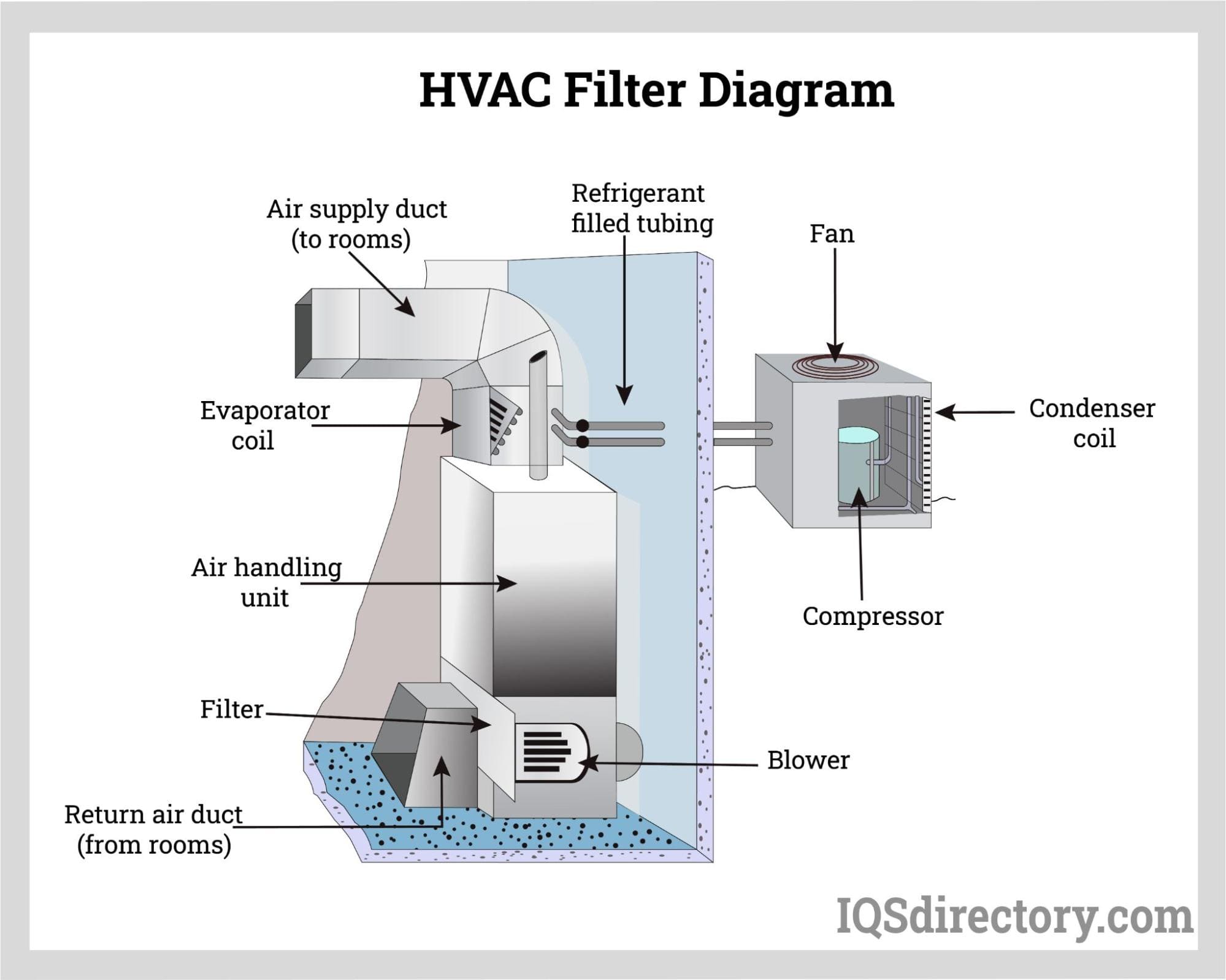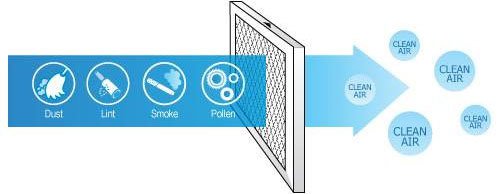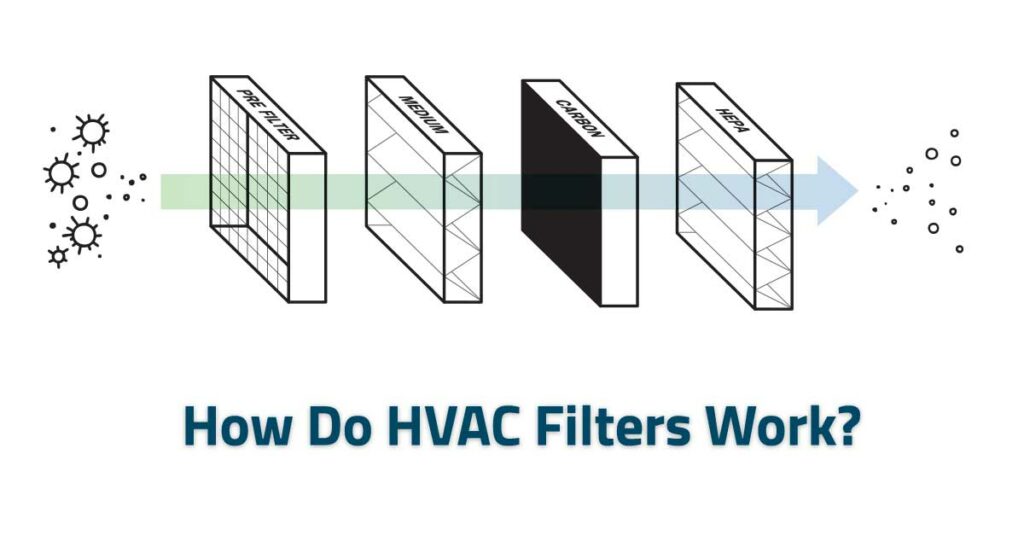An HVAC filter works by trapping dust, pollen, and other airborne particles. It ensures clean air circulates within the system.
HVAC filters are essential components in heating, ventilation, and air conditioning systems. They improve indoor air quality by removing contaminants from the air. Various types of filters, like fiberglass, pleated, and HEPA, offer different levels of filtration efficiency. Regularly changing or cleaning these filters is crucial for maintaining system performance and energy efficiency.
Clean filters prevent blockages, reduce strain on the HVAC system, and lower utility costs. Understanding the role of HVAC filters helps in making informed decisions about maintenance and upgrades.
Introduction To Hvac Filters
Understanding HVAC filters is crucial for maintaining indoor air quality. These filters play a vital role in heating, ventilation, and air conditioning systems. They trap dust, pollen, and other particles, ensuring clean air circulates in your home. Let’s dive deeper into the purpose and history of HVAC filters.
Purpose Of Hvac Filters
The primary purpose of HVAC filters is to remove contaminants from the air. Here are some key points about their function:
- Trap dust and dirt
- Remove allergens like pollen
- Filter out mold spores
- Enhance air quality
- Protect HVAC system components
By doing these tasks, HVAC filters help keep the air you breathe cleaner. They also prevent debris from clogging the HVAC system, which can improve efficiency and extend the system’s lifespan.
Brief History
HVAC filters have a long history. Early filters were simple and used in basic ventilation systems. Modern filters are more advanced and efficient. Let’s look at their evolution:
| Year | Development |
|---|---|
| 1902 | First modern air conditioning system invented by Willis Carrier |
| 1920s | Introduction of basic air filters |
| 1970s | HEPA filters became popular |
| 2000s | Improved filter materials and efficiency |
From simple beginnings to advanced technology, HVAC filters have come a long way. They now offer better air quality and system protection.

Credit: www.air-filters.org
Types Of Hvac Filters
Understanding the different types of HVAC filters is important. Each type has its own set of advantages. It helps in maintaining indoor air quality. Here are some common types of HVAC filters.
Fiberglass Filters
Fiberglass filters are the most basic type. They are made of spun glass. These filters are cheap and disposable. They catch large particles like dust and lint.
- Pros: Low cost, easy to replace
- Cons: Not very effective against small particles
Pleated Filters
Pleated filters are made from polyester or cotton folds. The pleats increase the surface area. This allows them to capture more particles. They are more efficient than fiberglass filters.
- Pros: Better filtration, longer lifespan
- Cons: Slightly higher cost
Hepa Filters
HEPA stands for High-Efficiency Particulate Air. These filters can capture 99.97% of particles. They are very effective for people with allergies. HEPA filters are used in hospitals and clean rooms.
- Pros: Excellent filtration, removes most allergens
- Cons: High cost, requires a compatible HVAC system
| Filter Type | Material | Efficiency | Cost |
|---|---|---|---|
| Fiberglass | Spun Glass | Low | Low |
| Pleated | Polyester/Cotton | Medium | Medium |
| HEPA | Dense Material | High | High |
Filter Mechanics
Understanding how HVAC filters work is crucial for home air quality. HVAC filters play a key role in removing dust and allergens. They also protect HVAC systems from damage caused by debris. This section will explain the mechanics of HVAC filters. We will explore the role of filter media and air flow dynamics.
The Role Of Filter Media
Filter media is the material that traps particles. It can be made from fiberglass, paper, or cloth. The media’s fibers create a maze for air to pass through.
As air flows, particles get trapped in the fibers. Smaller particles can be caught by electrostatic charges. Larger particles get stuck by the fibers’ density.
Here is a table showing common filter media types:
| Filter Media Type | Material |
|---|---|
| Fiberglass | Glass fibers |
| Pleated | Paper or cloth |
| Electrostatic | Specially treated fibers |
Air Flow Dynamics
Proper air flow is vital for HVAC systems. Filters must balance filtering particles and allowing air to flow.
High-efficiency filters trap more particles but can block air flow. Low-efficiency filters allow more air but trap fewer particles.
Filters have a Minimum Efficiency Reporting Value (MERV) rating. The MERV rating shows how well a filter traps particles. Higher MERV ratings mean better particle trapping but lower air flow.
Here is an unordered list of MERV ratings and their uses:
- MERV 1-4: Basic residential use, traps large particles.
- MERV 5-8: Better residential use, traps smaller particles.
- MERV 9-12: Superior residential use, traps even more particles.
- MERV 13-16: Hospital-grade, traps very small particles.
Choosing the right filter depends on your needs. Consider both air quality and HVAC system performance.
Filtration Efficiency
Filtration efficiency is crucial for maintaining clean air in your home. It determines how well your HVAC filter captures particles. The better the efficiency, the cleaner your air will be. Understanding this helps in choosing the right filter for your needs.
Merv Ratings Explained
The MERV rating measures a filter’s ability to capture particles. MERV stands for Minimum Efficiency Reporting Value. It ranges from 1 to 20. Higher ratings mean better filtration.
| MERV Rating | Particle Size Captured | Common Uses |
|---|---|---|
| 1-4 | 10.0 μm | Residential window AC units |
| 5-8 | 3.0 – 10.0 μm | Better residential and commercial use |
| 9-12 | 1.0 – 3.0 μm | Superior residential, better commercial, hospitals |
| 13-16 | 0.3 – 1.0 μm | Hospital surgery rooms |
| 17-20 | < 0.3 μm | Cleanrooms, pharmaceutical manufacturing |
Importance Of Filter Maintenance
Regular filter maintenance ensures optimal performance of your HVAC system. A clean filter captures more particles, improving air quality. Neglecting maintenance can lead to several issues:
- Reduced airflow
- Higher energy bills
- System breakdowns
Follow these simple steps for proper maintenance:
- Check your filter every month
- Replace it every 1-3 months
- Follow manufacturer guidelines
Impact On Air Quality
The HVAC filter plays a crucial role in maintaining air quality. It keeps the air inside your home clean and fresh. Understanding its impact can help you make informed decisions about your indoor environment.
Removing Contaminants
HVAC filters capture harmful particles from the air. These particles can include:
- Dust
- Pollen
- Pet dander
- Mold spores
- Bacteria
By trapping these contaminants, the filter prevents them from circulating. This leads to cleaner, healthier air in your living spaces.
Health Benefits
Clean air has many health benefits. Some of these benefits include:
- Reduced allergies
- Better respiratory health
- Improved sleep quality
A good HVAC filter can help reduce asthma symptoms. It also lowers the risk of respiratory infections. Clean air is essential for everyone, especially children and the elderly.
Below is a table summarizing the health benefits of using an HVAC filter:
| Health Benefit | Description |
|---|---|
| Reduced Allergies | Fewer allergens in the air |
| Better Respiratory Health | Less exposure to harmful particles |
| Improved Sleep Quality | Breathing easier at night |
Choosing the right HVAC filter is key. It ensures your home has clean air and supports your health.
Filter Installation And Replacement
Proper installation and regular replacement of HVAC filters are crucial. They ensure optimal performance and air quality. Understanding how to choose, install, and replace filters is essential.
Choosing The Right Size
Choosing the correct filter size is vital. Measure your old filter or check your HVAC system manual. Ensure the new filter matches the dimensions exactly. Incorrect sizes can lead to poor air quality and system inefficiency.
| Filter Dimension | Application |
|---|---|
| 16 x 20 x 1 inches | Small residential units |
| 20 x 25 x 1 inches | Medium residential units |
| 20 x 30 x 1 inches | Large residential units |
| 24 x 24 x 1 inches | Commercial units |
Step-by-step Guide
Follow these steps to install or replace your HVAC filter:
- Turn off the HVAC system: Ensure safety first.
- Locate the filter compartment: Usually near the air handler.
- Remove the old filter: Slide it out carefully.
- Inspect the filter slot: Clean if necessary.
- Insert the new filter: Ensure the arrows point in the airflow direction.
- Close the compartment: Secure it properly.
- Turn on the system: Check for proper operation.
Replacing filters regularly is essential. The recommended replacement interval is every three months. However, households with pets or allergies may need more frequent changes.
Common Issues And Troubleshooting
Understanding how your HVAC filter works is crucial. It helps maintain clean air and ensures your system runs efficiently. However, common issues can arise. Knowing how to troubleshoot these problems can save you time and money.
Clogged Filter Symptoms
A clogged filter can cause various issues. Here are some common symptoms:
- Decreased Airflow: Less air comes out of the vents.
- Increased Energy Bills: Your system works harder and uses more power.
- Allergy Symptoms: More dust and allergens circulate in your home.
- System Overheating: The HVAC unit may overheat and shut down.
Solving Airflow Problems
Airflow problems can be frustrating. Here are steps to solve them:
- Check the Filter: Remove and inspect the filter. Replace if dirty.
- Inspect Vents: Ensure all vents are open and not blocked.
- Clean the Ducts: Dirt and debris in ducts can restrict airflow.
- Check the Blower Fan: A malfunctioning fan can reduce airflow.
If these steps don’t help, consider calling a professional. Regular maintenance can prevent many issues.

Credit: www.galmicheandsons.com
Advancements In Filtration Technology
The world of HVAC filters is evolving rapidly. New technologies are making filters more efficient and eco-friendly. These advancements are improving indoor air quality significantly.
Smart Filters
Smart filters are now available. They connect to your phone. You can monitor their status easily. These filters send alerts when they need changing. This ensures optimal air quality at all times.
Eco-friendly Options
Eco-friendly filters are gaining popularity. They are made from natural materials. These filters can be recycled. This reduces waste and helps the planet. Eco-friendly filters are also very effective. They trap dust, pollen, and other particles.
| Type of Filter | Benefits |
|---|---|
| Smart Filter | Monitors status, sends alerts, ensures optimal air quality |
| Eco-Friendly Filter | Made from natural materials, recyclable, traps dust and pollen |
- Smart filters connect to your phone.
- Eco-friendly filters are made from natural materials.
- Both types improve indoor air quality.
- Choose the right filter for your needs.
- Monitor filter status regularly.
- Replace filters when needed for best performance.
These advancements make HVAC systems better. They help you breathe cleaner air. Investing in advanced filters is a smart choice.

Credit: donnellymech.com
Conclusion
Understanding how HVAC filters work is crucial for maintaining indoor air quality. Regularly changing filters can improve efficiency. This simple step helps extend the lifespan of your HVAC system. Clean air means a healthier living environment. Ensure you choose the right filter for optimal performance.
Stay proactive in maintaining your HVAC system.
